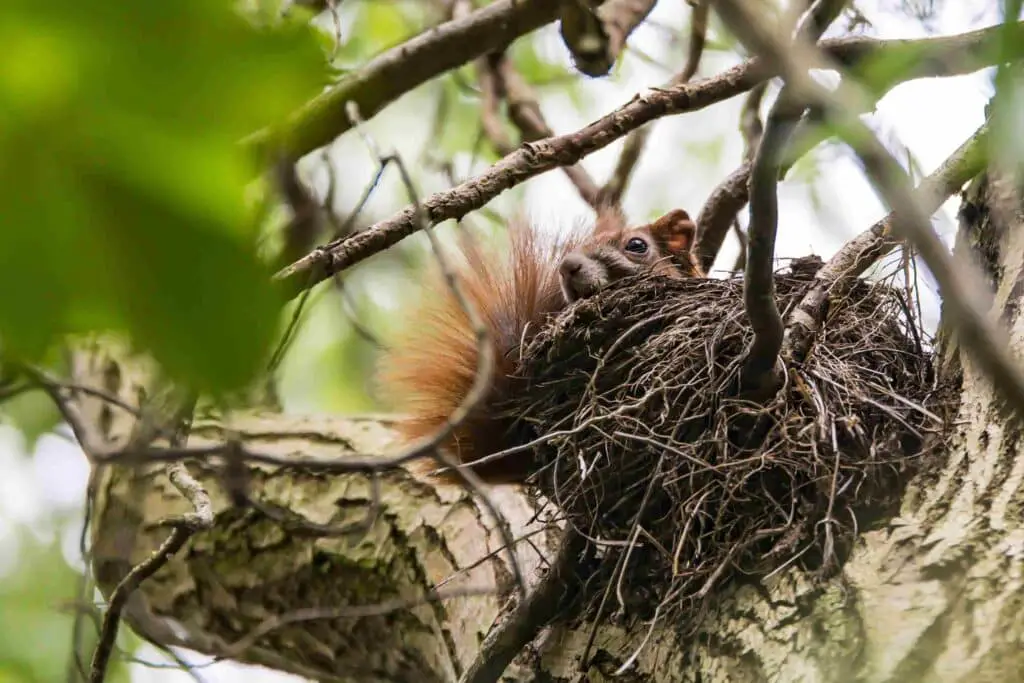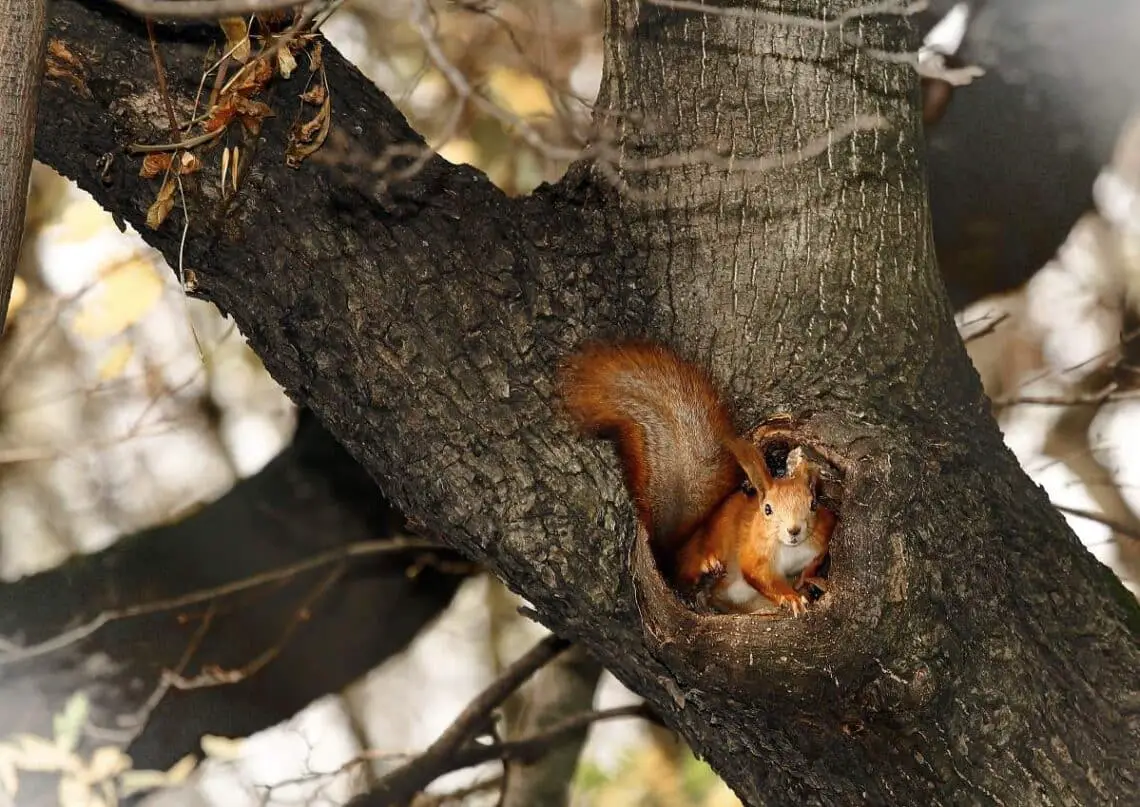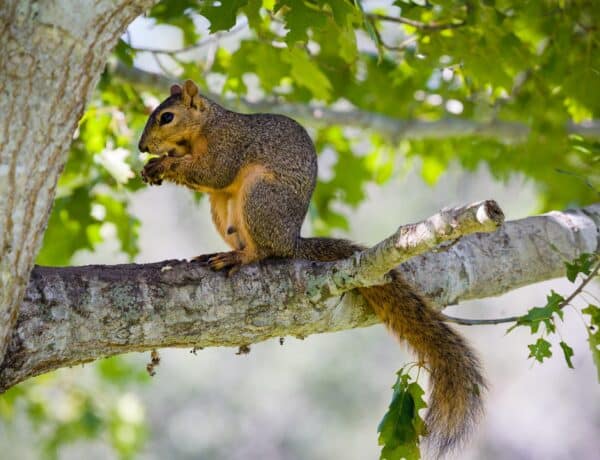Introduction
What Does A Squirrel Nest Look Like: Squirrels are fascinating creatures known for their agility, curiosity, and remarkable adaptability to various environments. These small mammals are often seen darting up and down trees, scurrying across power lines, and, perhaps most intriguingly, building nests high above the ground. These nests, often referred to as “dreys,” serve as safe havens for squirrel omnivore protection from predators and the elements. If you’ve ever wondered what a squirrel nest looks like, you’re in for a delightful exploration of these intricate and cozy abodes. A squirrel nest is a testament to nature’s architectural ingenuity, constructed with precision and care by these resourceful rodents. They are typically situated high up in trees, though ground squirrels may dig burrows for their nests.
These arboreal dwellings are meticulously crafted using a variety of natural materials, showcasing the squirrel’s innate ability to adapt to its surroundings. The primary material used in constructing squirrel nests is twigs and branches. Squirrels meticulously gather and arrange these components to form a sturdy outer structure, resembling a compact, spherical shape. These twigs serve as the nest’s foundation of structural integrity and protection against predators like birds of prey. To make the interior cozy and comfortable, squirrels line the nest with softer materials such as leaves, grass, moss, and even fur, creating a snug, insulated chamber.
This inner lining not only adds a layer of warmth but also ensures that the baby squirrels, known as kits, have a soft and secure place to rest and grow. Squirrel nests can vary in size, depending on factors like the species of squirrel and the availability of building materials. They are often situated in the crooks of branches or on sturdy limbs, where they are well-hidden from potential threats. This high vantage point offers several advantages, including a better view of their surroundings and enhanced protection against ground-based predators. Whether you’re a nature enthusiast, a homeowner curious about squirrel activity in your yard, or simply intrigued by the wonders of the natural world, understanding what a squirrel nest looks like will open a window into the captivating lives of these agile creatures.

What is in a squirrel nest?
Most squirrel nests are called dreys, and consist of clumped-together collections of leaves, twigs, bark, moss, and other compressed materials. They look like small, round bulbs of leaves bunched together. Squirrels usually build their dreys into tree cavities or around tree branches that are 20 feet high or higher.
Twigs and Branches: The primary building blocks of a squirrel nest are twigs and branches. These materials form the outer structure of the nest, stability and protection against the elements and potential predators. Squirrels meticulously gather and arrange these components to create a compact, spherical shape that serves as the nest’s foundation.
Fur and Feathers: Squirrels are known to incorporate fur and feathers into their nests, which further enhances their insulation properties. These materials are often obtained from their own bodies or from other animals they’ve preyed upon. The fur and feathers create an layer of warmth and protection within the nest.
Bark and Lichen: Some squirrel species use bark and lichen to camouflage the exterior of their nests. This them with a degree of protection from predators, as the nest blends in with the surrounding tree branches. Camouflaging the nest helps keep the squirrels hidden and safe.
What is called squirrel nest?
A drey is the nest of a tree squirrel, flying squirrel or ringtail possum. Dreys are usually built of twigs, dry leaves, and grass, and typically assembled in the forks of a tall tree.
Drey: The term “drey” is the most commonly used name for a squirrel’s nest. Dreys are typically built in trees, often high up in the canopy, and are characterized by their spherical or globular shape. They are constructed primarily from twigs and branches and lined with softer materials such as leaves, grass, moss, and sometimes fur or feathers. Dreys a secure and insulated space for squirrels to rest, give birth, and raise their young.
Nest Box: In some urban or suburban environments, people may nest boxes or squirrel houses as artificial alternatives for squirrels to nest in. These nest boxes mimic the natural dreys and can shelter, especially in areas where natural nesting sites are scarce.
Leaf Nest: Some squirrel species, like the southern flying squirrel, create leaf nests. These are constructed within tree hollows or cavities and are primarily composed of leaves. They offer a well-insulated and camouflaged space for these nocturnal squirrels to rest and rear their offspring.
What is the nesting place of squirrel?
There are two different types of squirrel nests that can be found in the trees surrounding your backyard: Tree cavity dens or leaf nests. Tree Cavity Den – A tree cavity den is often first created by a woodpecker, abandoned by that bird and later claimed by a squirrel.
Tree Dreys: The most iconic nesting place for many squirrel species is the tree drey. These spherical nests are constructed in the branches of trees, often high above the ground. Tree dreys are typically made from twigs, branches, and leaves, a secure and insulated shelter for squirrels. They are well-hidden among the foliage, offering protection from predators and the elements. Gray squirrels, red squirrels, and fox squirrels commonly build tree dreys.
Leaf Nests: Some squirrel species, such as the southern flying squirrel, prefer leaf nests. These are typically built within tree hollows or natural cavities and consist primarily of leaves. Leaf nests are particularly well-suited for nocturnal squirrels like flying squirrels, as they a soft and concealed resting place during the day.
Ground Burrows: Ground-dwelling squirrels, like chipmunks and groundhogs, create burrows as their nesting places. These underground tunnels serve multiple purposes, including shelter, protection from predators, and food storage. Burrows can be quite extensive and have multiple chambers for different uses, including sleeping and raising young.
What does a squirrel look like?
Squirrels are generally small rodents with slender bodies, bushy tails and large eyes. In general, their fur is short, soft and silky, and ranges in thickness from species to species. The color of their fur is also highly variable and can be whitish, gray, yellow, red, brown, or even black.
Body Size and Shape: Squirrels typically have a compact and slender body shape. Their size varies among species, with the smallest, like the African pygmy squirrel, measuring just a few inches in length, and the largest, such as the Malabar giant squirrel, reaching over three feet from nose to tail.
Fur Color: Squirrel fur comes in a wide range of colors and patterns, again depending on the species. Common colors include shades of gray, brown, red, and black. Some species, like the Eastern gray squirrel, have a predominantly gray coat, while others, like the American red squirrel, display a reddish-brown hue. There are also strikingly colored squirrels like the Indian giant squirrel, which boasts vibrant orange and black markings.
Tail: One of the most recognizable features of squirrels is their long, bushy tail. This tail serves various purposes, including balance, communication, and warmth during cold weather. It’s often held erect or in a graceful curve over the squirrel’s back. The tail’s coloration typically matches that of the squirrel’s body.
Where does a squirrel live?
Habitat. Ground squirrels prefer grassy habitats, such as open fields, pastures, and parks, and typically burrow into the ground to build dens. Conversely, tree squirrels and flying squirrels prefer dense woodlands and make their nests high in the treetops.
Forests: Many squirrel species are arboreal, meaning they live in trees. Forests, both temperate and tropical, abundant opportunities for squirrels to find shelter and food. They often create nests called dreys high up in the canopy, where they’re safe from ground predators and can easily access nuts and seeds from the trees.
Urban Areas: Squirrels are incredibly adaptable to human environments. They can be commonly found in cities and suburban areas, living in parks, gardens, and even nesting in the eaves or attics of buildings. Urban environments often a steady supply of food from gardens and bird feeders, making them attractive places for squirrels to inhabit.
Woodlands: Wooded areas, including both deciduous and coniferous forests, are home to various squirrel species. Tree squirrels, like the Eastern gray squirrel and the red squirrel, are often found in woodlands, where they build dreys in trees and forage for nuts and seeds.
Deserts: In arid regions, ground squirrels are common inhabitants. These squirrels dig burrows in the ground to escape the scorching heat and to protection from predators. They also store food in their burrows for times when resources are scarce.
What is squirrel called?
Squirrels go by the scientific name Sciuridae and belong to the kingdom Animalia and phylum Chordata. Their class is called Mammalia and the order is called Rodentia. The suborder is called Sciuromorpha, and the family is called Sciuridea too, just like the scientific name.
Gray Squirrel: The Eastern gray squirrel, one of the most familiar species in North America, is often simply referred to as the “gray squirrel.” It is known for its predominantly gray fur. The American red squirrel, or simply the “red squirrel,” is named for its reddish-brown fur. It’s found in North America and is known for its high-pitched vocalizations.
Flying Squirrel: Flying squirrels are a group of squirrels known for their unique ability to glide through the air using a membrane of skin called a patagium. There are various species of flying squirrels, including the Northern flying squirrel and the Southern flying squirrel. Ground squirrels are a group of squirrels that primarily live on or near the ground. Examples include the prairie dog, groundhog, and chipmunk. Each species often has its own specific name.
Tree Squirrel: This is a general term used to describe squirrels that live primarily in trees. Examples include the Eastern gray squirrel and the fox squirrel. Chipmunks are small, striped ground squirrels known for their cheek pouches and burrowing habits. They are commonly found in North America. Marmots are large, ground-dwelling squirrels found in various parts of the world. The groundhog, also known as the woodchuck, is a type of marmot.
What’s a baby squirrel look like?
Depending on their age, infant squirrels may have a short, thin coat of fur or no fur yet at all (see pictures below). They have a thin tail (not bushy) and their eyes may be closed or may have just opened. If you have found an infant squirrel, its best chance for survival is to be reunited with its mother.
Newborn squirrels are incredibly tiny, measuring just a few inches in length and weighing a few grams. They are typically hairless or have a very fine, short coat of fur that is often pink or pale in color. Their eyes are closed, and their ears are sealed, making them entirely dependent on their mother for care and nourishment.
Newborn kits are not able to move much and spend most of their time nestled in their mother’s nest. Around 3 to 4 weeks of age, baby squirrels begin to open their eyes, revealing dark, round pupils. Their ears also start to open, allowing them to hear sounds in their environment. At this stage, they are still quite small and may have a thin coat of fur that is still developing.
By 4 to 6 weeks, the baby squirrels’ fur becomes thicker and more developed, taking on the characteristic coloration of their specific species. Their tails, which were initially thin and scaly, start to become bushier as they grow. Baby squirrels become more active and may start to explore their nest.
What is the name of a squirrel’s home?
Squirrels are active all year round and do not hibernate. A squirrel lives in a nest known as a ‘drey’, comprising of a ball of interwoven twigs, lined inside with soft materials including moss, leaves, grass and fir.
The term “nest” is the most general and widely used term for a squirrel’s home. It encompasses a range of shelter types constructed by squirrels in various habitats. Dreys are the most common type of squirrel nest and are typically constructed in trees. They are often high up in the canopy to protection from ground-based predators. Dreys are made primarily from twigs and branches, forming a compact, spherical shape.
The outer layer of twigs stability and protection, while the inner chamber is lined with softer materials like leaves, grass, moss, and sometimes fur or feathers for insulation and comfort. Squirrel mothers use dreys as a safe place to give birth and raise their young, known as kits or pups. Some squirrel species, particularly flying squirrels, create nests within tree hollows or natural cavities. Leaf nests are primarily composed of leaves and a soft, concealed resting place during the day.
They are well-suited for nocturnal squirrels like flying squirrels, which are active at night. Ground-dwelling squirrels, such as chipmunks and groundhogs, create burrows as their homes. These underground tunnels serve as shelters, escape routes, and food storage areas. The burrows have multiple chambers for various purposes, including sleeping, raising young, and storing food.

Conclusion
In the world of squirrel nests, also known as dreys, is a testament to the remarkable adaptability and resourcefulness of these small, agile creatures. What a squirrel nest looks like is a fascinating blend of nature’s engineering and the squirrel’s innate survival instincts. These nests serve not only as shelter but also as a place of comfort and safety for these rodents throughout the year. Squirrel nests are constructed with great care and precision. They are primarily made from twigs and branches, forming a sturdy outer shell that protects against the elements and potential predators.
The interior is lined with softer materials like leaves, grass, moss, and fur, ensuring that the nest is a warm and snug haven for raising their young. The location of squirrel nests, high up in trees or sometimes in burrows for ground-dwelling squirrels, offers several advantages. It a safe refuge from ground-based predators and offers an elevated squirrels vantage point for spotting potential threats. It’s also a strategic choice for access to food sources, as squirrels can easily leap from their nests to nearby branches in search of nuts and other food items. Understanding what a squirrel nest looks like and how it’s constructed valuable insights into the lives of these creatures.
Observing squirrel behavior in your yard or local parks can be an engaging and educational experience. It fosters a greater appreciation for the intricate ways in which wildlife adapts to their surroundings and overcomes the challenges of survival. As we marvel at the architectural prowess of these tiny architects, let us also the of coexisting with wildlife. A safe and welcoming environment for squirrels and other creatures in our communities not only enriches our own lives but also contributes to the preservation of biodiversity. By appreciating the beauty and functionality of squirrel nests, we become more connected to the natural world and gain a deeper understanding of the delicate balance that sustains life on Earth.





No Comments